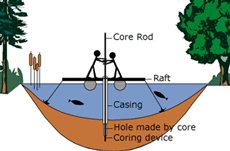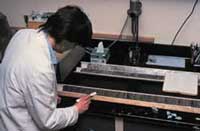Coring, Storing, and Sampling
 Coring
Coring
To study sequences (series) of fossil pollen, scientists obtain samples, or cores, of sediment from lakes or peatlands. Cores are typically taken in one-meter (about 3 ft.) sections, and sediment may be sampled to a depth of twenty meters or more.
Lakes in the Midwest typically have ten to twenty meters of sediment. To take the cores, palynologists lower a coring device from a well-anchored raft or, in the winter, from the frozen lake surface.
Storing
In
the field, cores are wrapped in plastic and aluminum foil and are packed
in plastic tubing for transport. They are stored in a cold room to prevent
drying and fungal growth until they can be studied further.
Sampling
Smaller
samples, typically 0.5 to 1.0 cubic centimeters, are taken at regular
intervals down the core. Seeds, charcoal, and pieces of wood are sieved
from the core for identification and radiocarbon
dating.

Sampling
the core in the lab.